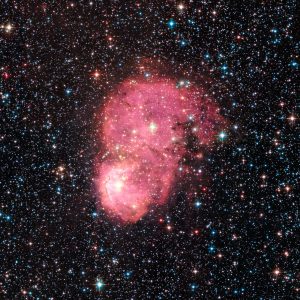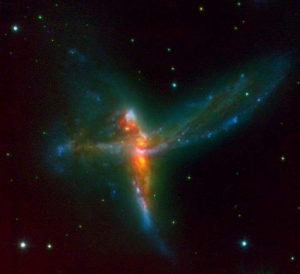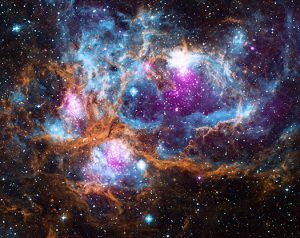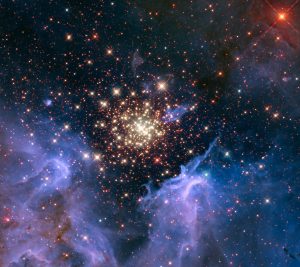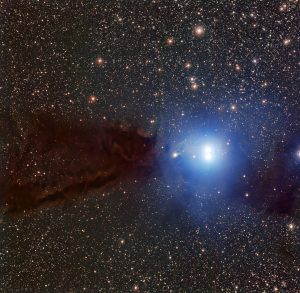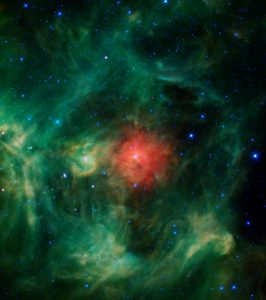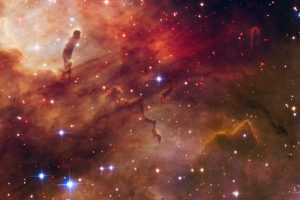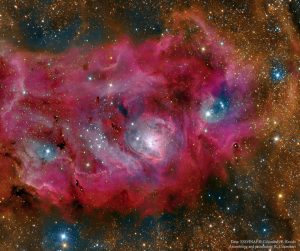formazione stellare
Luminarie accese nella Piccola Nube
Questa sfavillante nebulosa di un bel rosa intenso, immortalata con grande dettaglio dal telescopio Hubble e chiamata NGC 248, si trova nella Piccola Nube di Magellano, a circa 200.000 anni luce di distanza. Continua a leggere
Una Fatina Cosmica
Utilizzando il Very Large Telescope dell’ESO, un team internazionale di astronomi ha individuato uno splendido, raro caso di triplice fusione di galassie. Questo sistema, che gli astronomi hanno soprannominato L’Uccello (“The Bird”), anche se potrebbe assomigliare ad una fatina Trilly cosmica, si compone di due galassie a spirale massicce e una terza galassia irregolare. Continua a leggere
Paese delle Meraviglie Cosmico
Sebbene nello spazio non esistano stagioni, questo straordinario panorama cosmico ricorda un freddo paesaggio invernale dall’atmosfera magica. In questa fiabesca regione, chiamata NGC 6357, la radiazione delle calde, giovani stelle sta energizzando il gas più freddo nella nube circostante, facendolo brillare. Continua a leggere
Scintillio di Stelle
Una giovane, scintillante collezione di stelle si presenta come uno spettacolo celeste di fuochi d’artificio. L’ammasso è circondato da nubi di gas e polveri interstellari, la materia prima per la formazione di nuove stelle. La nebulosa, che si trova a 20.000 anni luce di distanza nella costellazione della Carena, contiene un ammasso centrale di stelle ardenti e massicce, chiamato NGC 3603. Continua a leggere
Luce dall’oscurità
Questa immagine fiabesca, ripresa dal telescopio dell’MPG/ESO a La Silla, mostra una nube oscura in cui stanno nascendo nuove stelle insieme ad un gruppo di astri splendenti già emersi dalle polveri in cui erano avvolti. Continua a leggere
Una Ghirlanda in Cielo
In perfetto spirito natalizio questa spettacolare nebulosa ripresa dal telescopio WISE della NASA ha l’aspetto allegro ed elegante di una festosa ghirlanda, ornata di un bel nastro rosso, sempreverde e lucine d’argento. Il nome ufficiale è Barnard 3 o IRAS G159.6-18.5, ma è stata soprannominata in modo appropriato, Nebulosa Ghirlanda. Nubi come questa sono nursery stellari, regioni in cui nascono nuove stelle. Continua a leggere
La Galassia Ruota di Carro
A circa 500 milioni di anni luce di distanza nella costellazione dello Scultore, la forma della Galassia Ruota di Carro (Cartwheel Galaxy) è il risultato di una collisione galattica violenta. Una galassia più piccola è passata attraverso il disco di una grande galassia e ha prodotto onde d’urto che hanno travolto gas e polveri, in modo simile alle increspature prodotte quando un sasso cade in un lago. Lo scontro titanico ha innescato nella regione intensi fenomeni di formazione stellare. Continua a leggere
Via Col Vento
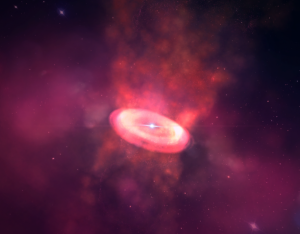 Vortici ventosi di gas accompagnano la nascita delle stelle. Questa è la conclusione di uno studio dei ricercatori del Niels Bohr Institute, University of Copenhagen, che hanno utilizzato il telescopio ALMA per osservare le fasi iniziali della formazione di un nuovo sistema solare. Continua a leggere
Vortici ventosi di gas accompagnano la nascita delle stelle. Questa è la conclusione di uno studio dei ricercatori del Niels Bohr Institute, University of Copenhagen, che hanno utilizzato il telescopio ALMA per osservare le fasi iniziali della formazione di un nuovo sistema solare. Continua a leggere
Una Nidiata di Stelle Bambine
Questa splendida ripresa del telescopio Hubble mette in evidenza una parte delle nubi che circondano la famosa immagine dell’ammasso Westerlund 2, che contiene alcune delle stelle più calde, luminose e massicce conosciute, nella costellazione della Carena. Gli astri brillanti riversano torrenti di luce ultravioletta e intensi venti di particelle cariche che spazzano e scavano l’avvolgente nube di idrogeno gassoso. Continua a leggere
La Nebulosa Laguna in Alta Definizione
Le stelle combattono gas e polveri nella Nebulosa Laguna ma vincono… gli astrofotografi. Nota anche come M8, questa fotogenica e spettacolare nebulosa è visibile anche ad occhio nudo in direzione della costellazione del Sagittario. Continua a leggere
